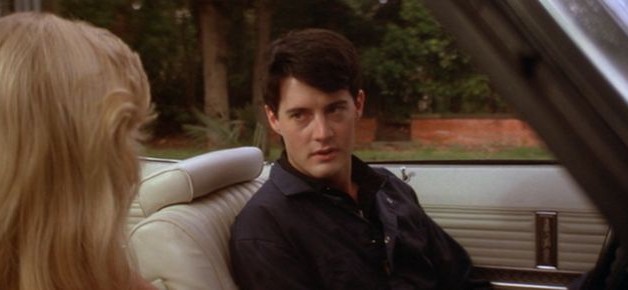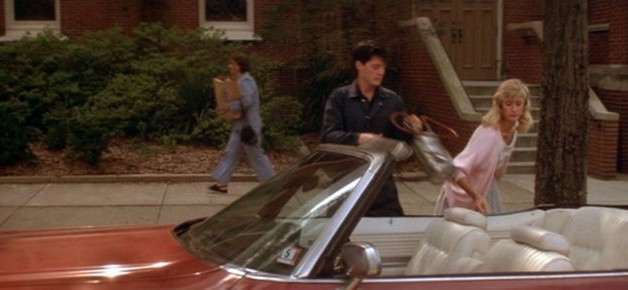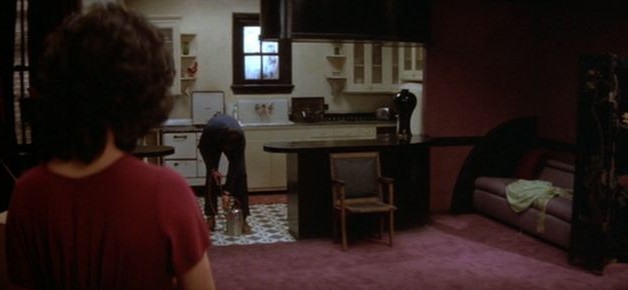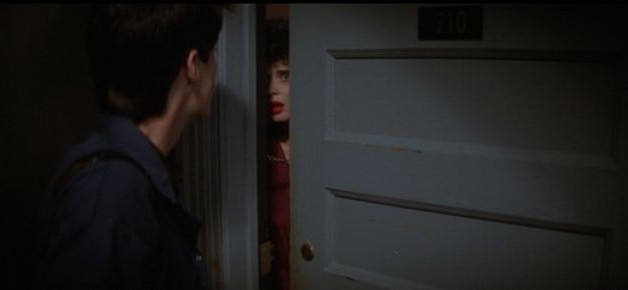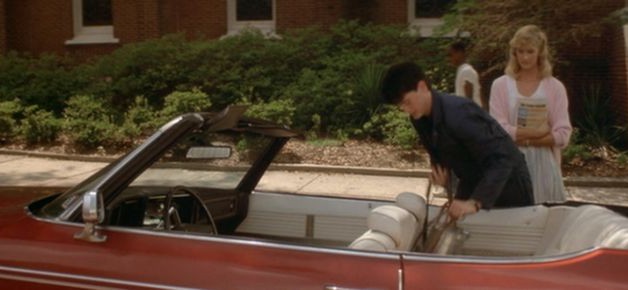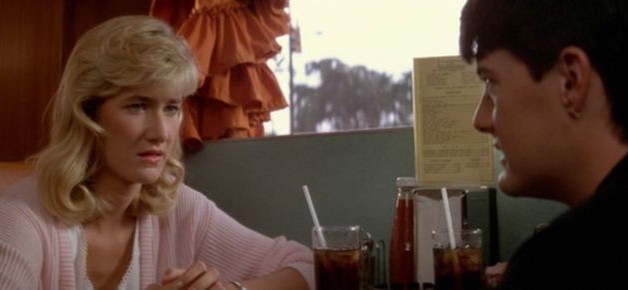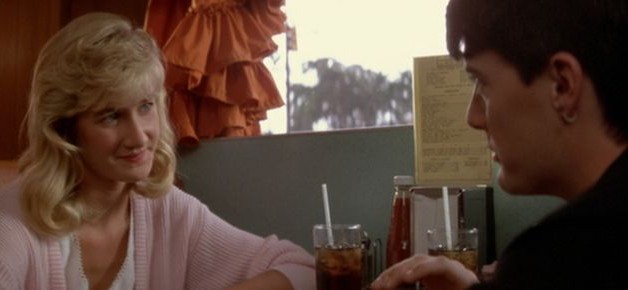The Blue Velvet Project
Blue Velvet, 47 seconds at a time by Nicholas Rombes
-
 The Blue Velvet Project, #33
The Blue Velvet Project, #33
Second #1551, 25:51 Jeffrey: I’m gonna try to sneak in tonight. It’s Friday. Do you have a date? Sandy: Yeah. I do. Jeffrey: Well. (pause) That does that. * “The historian of cinema faces an appalling problem. Seeking in his subject some principle of intelligibility, he is obliged to make himself responsible for every frame of film in existence. For the history of cinema consists precisely of every film that has ever been made, for any purpose whatever.” –Hollis Frampton * For a time, in the 1980s, it seemed as if Reagan’s victory would be permanent. There was comfort in… Read more
-
 The Blue Velvet Project, #32
The Blue Velvet Project, #32
Second #1504, 25:04 The woman in the background carrying groceries has a story to tell. She has her own secrets, in that purse, and for approximately two seconds she becomes a part of Blue Velvet. Perhaps an unremembered part, called forth in the same way that Douglas Gordon’s 24 Hour Psycho—which slowed down Psycho to two frames per second, stretching the film’s duration to 24 hours—made it possible to see details in a new way. In Point Omega, Don DeLillo captures the dislocating feeling of looking very, very closely at something, brought about by a character watching 24 Hour Psycho:… Read more
-
 The Blue Velvet Project, #31
The Blue Velvet Project, #31
Second #1457, 24:17 The Yellow Man has come and gone. Dorothy’s full attention is on Jeffrey now. This first apartment scene is shot largely from Dorothy’s general angle of vision and in this frame she is dangerously close to the camera. In D.W. Griffith and the Origins of American Narrative Film, Tom Gunning explores the subtle but important changes in camera distance in the early 1900s: The basic camera distance for most shots in 1909 crept closer than the distant tableau found in some of Griffith’s first films. The full shot of the character from head to toe predominates over… Read more
-
 The Blue Velvet Project, #30
The Blue Velvet Project, #30
Second #1410, 23:20 The sound. A low hum, like the over-filtered wail of a distant train or a collapsing carnival from some fevered dream. Within a few seconds of this shot that sound creeps into the film, and by the time the Yellow Man knocks at the door (roughly eight seconds after this frame) it will feel as if the sound is seeping out from the architecture of the room itself. Dorothy, in her red dress, pretends to attend to her fingernails, a sure sign that she already desires Jeffrey. The pink, plush, un-patterned carpeting. The lone chair, facing forward,… Read more
-
 The Blue Velvet Project, #29
The Blue Velvet Project, #29
Second #1363, 22:43 The fact that Dorothy’s frightened gaze fixes on the camera—on us—means something, but what? The frame, bisected by the vertical gap that leads into her apartment, is given dark force by the accumulated black that collects behind Jeffrey. He’s not entering a “dark world,” but bringing a dark world into her apartment. A counter-reading of Blue Velvet, based on frames like this, suggests that it is Jeffrey’s presence–as much as Frank’s–that invokes the film’s dark angels. Laura Mulvey, in Death 24x a Second, wrote that: Now that films on DVD are indexed in chapters, the linearity associated… Read more
-
 The Blue Velvet Project, #28
The Blue Velvet Project, #28
Second #1316, 21:56 A stairway exposed / A monastic image / Deep River Apartments / The silence of the film / The sound of sound / Has come apart / I’d like to think / In curved brick archways / The light / The 90 degree angles / Against that light / The Bug Man / Auden: “The bug whose view is balked by grass” / The steady climbing / Of the stairs / Then dark / Then Frank / What light will come of this? / The metal handrail across the door / A chance to stop the frame… Read more
-
 The Blue Velvet Project, #27
The Blue Velvet Project, #27
Second #1269, 21:09 We don’t know it yet, but the faint buzzing sound of static we hear at this point comes from the flickering red neon ELEVATOR sign that Jeffrey—emerging from the far right side of the frame—will encounter in a few moments. Ian Watt—the great deconstructor of the barely visible codes of narrative fiction—once described the actions of a character named Kayerts in Joseph Conrad’s short story “The Outpost of Progress” and in doing so introduced the phrase “delayed decoding” to describe how Conrad sometimes placed readers in the position of his characters, for whom events unfolded more quickly… Read more
-
 The Blue Velvet Project, #26
The Blue Velvet Project, #26
Second #1222, 20:22 A bug man, a Jehovah’s Witness, and an anonymous cleaning man converge in the frame. It is near this point that Blue Velvet begins trembling under the weight of its own narrative expectations: what will Jeffrey find in Dorothy’s apartment? Will he get caught? What does Sandy really think of what’s happening? The framing follows the elegant horizontal lines of Jeffrey’s convertible, and the movement over the next few moments will follow the direction of the car, from right to left. Sandy holds copies of Awake! magazine, slipping into the role of Jeffrey’s accomplice and the religious… Read more
-
 The Blue Velvet Project, #25
The Blue Velvet Project, #25
Second #1175, 19:35 Confession: the first time I saw Blue Velvet—and each subsequent viewing has only reinforced this—I’ve always felt that when Jeffrey pleads with Sandy at this moment (“Sandy, let’s just try the first part”) he’s talking about sex. What sort of plan is Jeffrey hatching, and is Sandy agreeing to? In their classic 1969 essay “Cinema/Ideology/Criticism,” Jean-Luc Comolli and Jean Narboni ask whether it’s possible for any film to escape the ideological boundaries of its making. While most films, they argue (Marxist cultural determinists that they were!), can never break free of the gravitational forces of ideology, there… Read more
-
 The Blue Velvet Project, #24
The Blue Velvet Project, #24
Second # 1128, 18:48 1. “The first thing I need,” Jeffrey tells Sandy, “is to get into her apartment and open a window that I can crawl into later.” As it turns out, this plot line never develops, as Jeffrey spots a key to Dorothy’s apartment which he takes instead. It seems like a minor point, the window, (although in the apartment in his bug overalls Jeffrey does glance twice at the window above Dorothy’s sink) and we soon forget about it. It’s one of those moments in Blue Velvet that only obliquely and in the most obscure ways references… Read more
